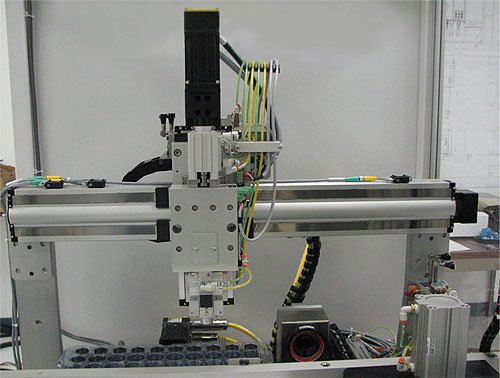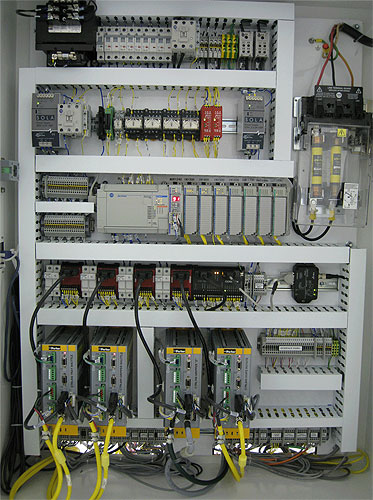Cim-Tech Corp. was commissioned to build a machine that automatically assembles four components of a surgical instrument. The axes of the XYZTheta had to orient one assembly consisting of a cylindrical surgical knife pressed into the end of a staple pusher, and place it inside another assembly consisting of a rod insert in an exterior shell. One challenge was to execute these motion actions smoothly and accurately. Another challenge was to integrate the motion controller with the system PLC.

One axis of the XYZTheta machine shuttles a tray of knives from an operator loading/unloading station and positions it in the Y-axis under a knife gripper end-effecter. The gripper is mounted on X and Z-axes. These axes deliver a picked-up knife to the knife orientation nest, the pusher nest, and the shell nest.
To meet these challenges, Cim-Tech engineers chose Parker Hannifin servo drives communicating over DeviceNet to an Allen Bradley PLC.
“Historically we have used a separate motion controller to control all of the axes’ motion and a PLC as the core machine control component,” said Bill Courchaine, senior sales engineer, Cim-Tech. “That required that these devices each contain software and communicate via I/O or serial interface. Plus, tying these two devices together and coordinating them can be cumbersome and time consuming.”
One axis shuttles a tray containing 79 knives from an operator loading/unloading station. This axis also positions the knife tray in the Y-axis under a knife gripper end-effecter. The gripper is mounted on X and Z-axes. These axes deliver a picked-up knife to the knife orientation nest, the pusher nest, and the shell nest. The fourth axis rotates the knife orientation nest.
A Cognex Insight vision system captures an image of the knife and finds the position of two holes placed in the side of the knife. These holes must be lined up with fixed pins on the gripper. Each hole position is written to the PLC that then initiates a move to the orientation nest axis to correct the angle of the knife. The knife is then picked up by the gripper.
The gripper moves the knife to the pusher nest. An operator has loaded pusher and shell/rod components into their respective nests. The Z axis for the gripper extends down to press the knife into the pusher. The knife and pusher are then raised together, moved to the shell nest, and placed inside the shell.

Compax3 servos communicate over a DeviceNet master scanner module in the control PLC. All motion calls, position, velocity, and acceleration values, and drive status parameters are continuously updated between the PLC and drives.
Cim-Tech engineers made use of the DeviceNet function of Parker’s Compax3 servo drives by installing a DeviceNet master scanner module in the PLC. All motion calls, position, velocity, and acceleration values, and drive status parameters are continuously updated between the PLC and drives.
Operators simply enter setup information in each drive, and the PLC motion control program manages the motion. “As this becomes our standard for future motion control projects, we expect that it will greatly reduce our engineering labor costs per project,” says Courchaine.
Since the pick up and orientation of the knives is independent of operator action, the machine is designed to do this while the operator loads parts. The load station is designed with a unique, intrinsically safe access scheme; this permits the operator to load and unload parts in a minimum amount of time, without ever interrupting the sequence of the machine. As a result, throughput exceeded customer requirements by 67%.
Parker Hannifin
www.parker.com






Leave a Reply
You must be logged in to post a comment.